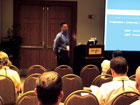Sustainable manufacturing, innovation management, continuous improvement-these were some of the critical challenges facing food and beverage processors discussed in 14 presentations spanning three days in April at Food Engineering’s Food Automation & Manufacturing Conference and Expo in Orlando, FL.
Keynoter Diane Wolf of Kraft Foods Inc. devoted a significant part of her presentation to the opportunities and challenges of business sustainability. If slashing waste cuts cost and reduces a plant’s “carbon footprint,” sustainability is economically justified, the vice president of global engineering said. But if social and environmental value is the only rationale, sustainability becomes murky, she said.
At the plant level, quality production as a ratio of the input of raw materials, energy and people yields a mass efficiency percentage that provides a useful measure of sustainability. “We have shamelessly stolen and are applying at Kraft a mass balance tool from a company called Interface,” a carpet manufacturer committed to raising its mass efficiency to 60 percent, she said. The balance represents waste. Kraft’s plants are below 20 percent efficient, “and no one can be proud of 20 percent,” she said.
Change is rippling throughout the Northfield, IL-based corporation, and engineering and manufacturing are affected by the push to rekindle growth. “I have a core competency in closing plants,” Wolf ruefully noted, but the worst of downsizing is past. Now production professionals are focusing on new products such as Oscar Mayer Deli Creations, a complete meal assembled from several Kraft products. “This is an engineering nightmare, but this is the direction many are moving” to better serve consumers, she said.

Engineers
know how to network and socialize, as demonstrated by Harry Pettit (left),
Pepperidge Farms’ systems and infrastructure engineering manager; Dean Ford,
director enterprise application integration at Maverick Technologies; and Phil
Frechette, president of JCS Controls.
Risk resides in uncertainty, and when companies focus on innovations with high technical uncertainty or market uncertainty or both, they must use “stepping stones” to lower risk. To illustrate, Hurley cited his firm’s development of filtration and evaporation technologies for non-thermal treatment of cloudy juices. Extensive study and knowledge-gain preceded any equipment purchases. Even then, leasing options were explored.
A similar approach is taken by Select Milk Producers Inc., Artesia, NM, a cooperative that has grown from sales of less than $10 million in 1994 to $600 million, primarily through strategic partnerships. “If the gut feel for a project is good and the capital investment doesn’t risk our organization, we go ahead,” said John Dunker, vice president-business development. “And when projects have failed, we pulled out quickly.”
Select Milk has become a major supplier to Kraft through its involvement in Southwest Cheese, a Clovis, NM, megaplant that produces 725,000 lbs. of cheese each day. The $200 million facility opened in 2005 in partnership with Glanbia Foods (which operates it), Dairy Farmers of America and firms such as Westway Feeds, which turn byproducts into value-added ingredients. The plant added needed production capacity for the millions of gallons of milk Select’s members produce each day, explained Dunker, but the project was a huge leap because “I was the only one in the company who’d been in cheese before.” The partnership with Glanbia was forged after evaluating eight other cheese manufacturers, and extensive site investigation and economic-incentive evaluations preceded 2004’s groundbreaking.
Advanced filtration, high-efficiency evaporation, logistics pooling-Select has been involved in a number of initiatives in partnership with commercial firms and academia, notably Cornell University, North Carolina State and University of California-San Luis Obispo. “Technology and innovation doesn’t have to be complicated,” he summarized. “A lot of times, simple can be better.”

Half-hour
technology presentations drew a steady stream of attendees to the Solutions
Theater venue.
Technical and people power
Continuous improvement is front and center in today’s food manufacturing, and both technology and human capital are being invested to make organizations more efficient and effective. Two speakers described organizational changes underway at their companies to effect continuous improvement, while another duo described how manufacturing execution systems (MES) aided their efforts.An engineering background characterizes the continuous improvement team organized a year and a half ago at Campbell Soup, which is important when using data-driven tools like root cause failure analysis, according to Jim Prunesti, director-reliability and manufacturing engineering. But in applying those tools throughout the organization, Prunesti’s team has been careful to avoid the perception that continuous improvement is the program of the day at Campbell and will soon pass. “Continuous improvement has to be looked on as the job, not part of the job,” he said. “Engagement is key. If you don’t get the workforce engaged, you’re not going to get a breakthrough change.”
While engaging the workforce with a team approach and an understanding of WIIFM (what’s in it for me?) is important, a commitment to continuous improvement begins with corporate leadership, Prunesti emphasized. Scott Butler, who has led a similar initiative at Del Monte Foods’ 22 plants since 2005, echoed that sentiment. McKinsey & Co. recommended lean implementation, and senior management endorsed the proposal “with very aggressive goals,” the vice president of operations services disclosed: safety-incident reductions and quality improvements in the order of 90% are sought, along with lead-time reductions of 75% and 50% cuts in lead time, WIP and space utilization. Visual factory, value stream mapping and other lean tools are being deployed, but organizers are careful to avoid labels buried in the been-there, done-that graveyard. Kaizens are organized, but they are dubbed “high impact events,” explained Butler. Even the lean label is off limits: the program is known as the Del Monte Production System.

The
Expo provided attendees an opportunity to familiarize themselves with products
and services designed for food industry professionals in a relaxed setting.
The implementation expense of MES can be even more daunting, but ROI can be just as impressive, suggests Doug Dornbier, vice president-operations at the North Lawrence, NY, plant of Breyers Yogurt Co. He credits last year’s MES initiative with not only providing management with a consolidated, real-time view of performance and quality, but also for motivating workers and making process improvement part of the plant’s culture.
Dornbier is one of only two managers remaining from the plant’s days as a Kraft unit. Kraft sold it to Cool Brands in 2005, and early this year it was sold again to an equity group. About 40% of the workforce is new.
The prior MES was regarded as intellectual property by Kraft and was not part of the asset sale. Dornbier wanted the new software to report performance and costs in a single format, rather than through multiple data-collection systems, and he wanted it to support lean manufacturing initiatives. A package called Manufacturing Visual Intelligence (MVI) was selected, and the program has keyed a number of improvement “campaigns” already. A misaligned foil campaign on one line boosted case volume by 247,000 on an annualized basis, for example, a $98,573 improvement.

An
attendee directs a question to one of the conference speakers. Besides a Q-and-A
at the end of each presentation, food professionals had ample opportunity to
interact with speakers at informal gatherings throughout the program.
Beyond operational improvements, MES packages like Vigilistics also are essential for an effective track & trace program, he said. At Riverside Creamery, the presence of caustic cleaner in a condenser was flagged one morning, “a huge liability that we got our arms around because of this,” Westervelt recalled.
Virtually every food regulation can be traced to a failure in the industry to control processes. Track & trace programs are crucial to maintaining control and avoiding product recalls. “Companies never recover from Class 1 recalls,” observed Westervelt. “Spinach sales are down 30% from last fall’s recall; they’ll never recover.”
Pathogen contamination of produce was broached in a presentation by Rick Winfree, senior director of engineering for the Taco Bell restaurant chain. Though speed to market and the tradeoffs between outsourced sandwich assembly and on-premise preparation was the focus of his talk, December’s E. coli poisonings of 60 Taco Bell customers came up in the Q&A session. Though the source of the contamination was never found, lettuce from California’s Salinas Valley was the prime suspect.
“We are absolutely going to set a new standard in how we monitor produce as it goes through the supply chain,” Winfree declared. “For the first time [this week], produce growers let us into their fields [and] are finally working with us, and that is encouraging. This is a major control issue, and it’s not going to go away.”

Top Trends Affecting Food Industry
Keynote speaker Diane Wolf, vice president-global engineering at Kraft Foods, flagged several trends and challenges that are reshaping the food industry. They include:1. China and India’s influence on global economic growth patterns
2. Energy prices that will remain high and volatile
3. Bio-fuel growth is driving up commodity prices
4. Demand for more sustainable business practices
5. Improvement in mass balance at the factory level
6. Low-cost country sourcing and the integration of external service providers
7. Lower production costs without compromising quality
8. Improve manufacturing speed and agility
Extremes in outsourcing
While competitive advantage distinguishes core competencies from outsourced engineering in manufacturing, how food companies define their competitive advantages results in broad differences in in-house engineering.That fact was apparent at “The Great Debate: Insourcing vs. Outsourcing Engineering,” a special strategy session at Food Automation and Manufacturing Conference. Top engineers from four manufacturers addressed the issue, and how they defined competitive advantage explained their staffing levels, which ranged from 400 engineers at Anheuser-Busch Inc. to nine at the corporate level of Coca-Cola Co. Marketing is Coke’s core competency, explained Engineering Manager Chuck Hollingsworth, though the organization is reappraising the value of engineering competency. Expertise in controls and automation deteriorated, “and we’re really seeing the effects of that loss,” he said. Coke has reemphasized those areas in recent years.
Process knowledge “that we retain and don’t want generally known on the outside” qualifies as a core competency, said Jerry Eyink, group director-project management, Anheuser-Busch. “Automation has grown as a core competency.” Nonetheless, the firm must tap outside experts on occasion, and those engineering firms are carefully screened before they can work on a project. “We don’t solicit bids; we solicit engineering proposals,” Eyink said.
Like A-B, General Mills Inc. relies on a cadre of long-time collaborators when it goes outside a staff of 175 corporate and 200 field engineers, noted Bob Johnson, director of process engineering. “A 20- or 30-year relationship helps us get the right people working on a project,” Johnson pointed out. As General Mills puts a greater emphasis on innovation, engineering is soliciting more input from exterior resources, as well as from inside the organization, he added.
Corporate consolidation dropped the corporate engineering staff at HJ Heinz Co. to two, though the group has been bolstered to a dozen in recent years, said Sam Casey, Heinz director of engineering. Corporate serves a support role for plant engineers. “We’re really relying on our factory engineers to drive innovation,” he said.
Regardless of different staffing levels, the engineers found common ground in the increased importance of project management as a key skill set for manufacturing engineers. They also expressed reservations of global sourcing of both manufacturing equipment and engineering talents. While local engineers are needed when a plant is built halfway around the world, offshoring of domestic engineering is problematic. “We have done it in the past, with very little success,” said Eyink.